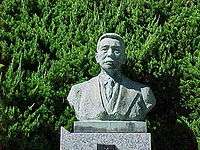Sahachiro Hata
| Sahachirō Hata | |
|---|---|
 Dr Paul Ehrlich & Dr Hata Sahachirō | |
| Born |
March 23, 1873 Masuda, Shimane, Japan |
| Died | November 22, 1938 (aged 65) |
| Alma mater | Okayama University |
| Known for | Arsphenamine |

Sahachirō Hata (秦 佐八郎 Hata Sahachirō, March 23, 1873 – November 22, 1938) was a Japanese bacteriologist who assisted in developing the Arsphenamine drug in 1909 in the laboratory of Paul Ehrlich.
He was nominated for the Nobel Prize in Chemistry in 1911 and for the Nobel Prize in Physiology or Medicine in 1912 and 1913.[1]
Hata was born in Tsumo Village, Mino District, Shimane (now part of Masuda City), and completed his medical education in Kyoto. He studied epidemic diseases under the famous Dr. Kitasato Shibasaburō at Kitasato's Institute for the Study of Infectious Diseases in Tokyo, and later studied immunology at the Robert Koch Institute in Berlin. While in Germany, he took the opportunity to learn about chemotherapy at the German National Institute for Experimental Therapeutics in Frankfurt, where he assisted Paul Ehrlich in the discovery of arsphenamine, which proved effective in curing syphilis. It was called Salvarsan 606 because it was the 606th drug that Ehrlich tried.
After his return to Japan, he helped found the Institute (now Kitasato University), of which he became a director. He also lectured at Keio University.
References
- Low, Morris. Building a Modern Japan: Science, Technology, and Medicine in the Meiji Era and Beyond. Palgrave Macmillan (2005). ISBN 1-4039-6832-2
- Porter, Roy. Blood and Guts: A Short History of Medicine. W. W. Norton & Company; Reprint edition (June 2004). ISBN 0-393-32569-5
- Waller, John. The Discovery of the Germ: Twenty Years That Transformed the Way We Think About Disease ("Revolutions in Science" series). Columbia University Press (2003), ISBN 0-231-13150-X
External links
| Wikimedia Commons has media related to Hata Sahachiro. |
- Hata Sahachiro Memorial Museum, Shimane (Japanese site)